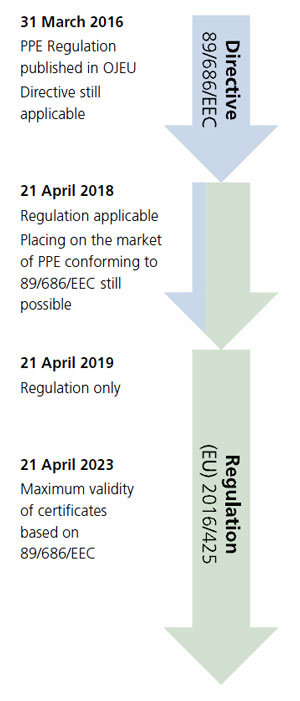KANBrief 2/16

With publication of Regulation (EU) 2016/425 on personal protective equipment (PPE) in the Official Journal of the EU (Official Journal of the EU L81, 31 March 2016, p. 51), the revision over many years of the PPE legislation has been brought to its conclusion. The regulation is to be applied as of 21 April 2018, at which point the existing 89/686/EEC PPE Directive will be repealed. Manufacturers, test bodies and other affected parties should use the transition period to adjust to the new regulation.
The European Parliament and the Council have been discussing the proposal made by the European Commission (See KANBrief 4/13 (pdf): Revision of the PPE Directive: what's new, what isn't?) for two years, and have now agreed upon a joint text. The new regulation applies directly in all Member States without having to be transposed into national law. By adaptation to the New Legislative Framework and inclusion of experience gained with application of the PPE Directive, a modern body of regulations is now available for the area of PPE.
What's new? (A comprehensive article (pdf, in German))
The PPE Regulation extends the scope of the PPE Directive slightly. PPE for protection against heat and intended specifically for private use, such as oven gloves, is now also covered. A recital makes it clear that the PPE Regulation also applies to distance selling, i.e. sales over the Internet.
The EU declaration of conformity must be supplied with each individual item of PPE placed on the market. Alternatively, the option exists for the content of the declaration to be stated in the user information. This includes a web address at which the declaration of conformity is available in full.
Each item of PPE must be assigned to a risk category from I to III. Category III has been extended with the addition of the following risks: drowning, cuts by hand-held chainsaws, high-pressure jets, bullet wounds and knife stabs, and harmful noise. The corresponding forms of PPE are therefore subject to the highest level of the conformity assessment procedures.
The PPE Regulation contains preliminary remarks on the essential health and safety requirements. The Machinery Directive served as the model for these remarks. Reference is now also made in the area of PPE to the state of the art for satisfaction of the essential health and safety requirements. In addition, a risk assessment is now mandatory. During the design and manufacture of PPE, consideration must be given not only to the intended use of the equipment, but also to reasonably foreseeable uses. For the most part, the essential requirements themselves have undergone only linguistic editing. A further new addition is the clear provision that protective clothing containing removable protectors is to be assessed as a combination during conformity assessment procedures. Skin protection has been added to the provisions concerning protection against non-ionizing radiation. Previously, these provisions were limited to eye protection.
The validity of the EU type-examination certificate will be limited in future to a maximum of five years. Precise circumstances are listed under which the manufacturer is obliged to submit the type-examination certificate to review. A simplified procedure is described for extension of the certificate at the end of its duration of validity.
What applies as of when?
The provisions concerning notified bodies are applicable as of 21 October 2016. This ensures that the notified bodies are prepared in time when the PPE regulation as a whole becomes applicable on 21 April 2018. The PPE Directive will be withdrawn on this date. The following year will be a transition period: PPE satisfying the directive may continue to be placed on the market. Type-examination certificates issued under the directive will remain valid until 21 April 2023, unless their validity lapses before this date.
Need for interpretation
The provisions concerning the transition period in particular raise questions for the stakeholders. The European Commission should address this by formulating an interpretation paper as soon as possible, with the involvement of these groups. Only by this means can it be assured that the provisions are applied consistently throughout the European Union. This paper must also include information on the presumption of conformity to which harmonized standards give rise: clear arrangements are required concerning the extent to which the list of standards under the directive the references of which have already been published in the Official Journal of the EU also applies to the new regulation. This must further be accompanied by production of a guide containing explanations and examples in order to support users in interpretation of the PPE Regulation.
Michael Thierbach